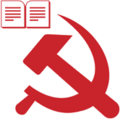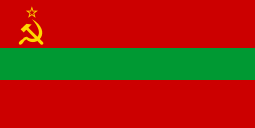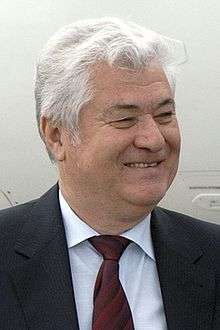Party of Communists of the Republic of Moldova
Party of Communists of the Republic of Moldova Partidul Comuniștilor din Republica Moldova Партидул Комуништилор дин Република Молдова Партия коммунистов Республики Молдова | |
|---|---|
 | |
| President | Vladimir Voronin |
| Parliamentary group leader | Violeta Ivanov |
| Founded | October 22, 1993 |
| Headquarters | Chişinău |
| Membership (2014) | 40,000[1] |
| Ideology |
Communism Marxism–Leninism Democratic socialism[1] |
| Political position | Left-wing |
| European affiliation | Party of the European Left |
| Continental affiliation | Union of Communist Parties – Communist Party of the Soviet Union |
| Colours | Red |
| Slogan | Republic! Power to the people! Socialism! |
| Parliament |
21 / 101 |
| District Presidents |
1 / 32 |
| Party flag | |
 | |
| Website | |
| pcrm.md | |
The Party of Communists of the Republic of Moldova (Romanian: Partidul Comuniștilor din Republica Moldova (PCRM), Moldovan Cyrillic: Партидул Комуништилор дин Република Молдова (ПКРМ), Russian: Партия коммунистов Республики Молдова, Partiya kommunistov Respubliki Moldova) is a communist party in Moldova, led by Vladimir Voronin. It is the only communist party to have held a majority in government in the post-Soviet states.[2]
The PCRM is part of the Party of the European Left.
Activity
It is currently supporting the coalition government of Moldova on a confidence and supply basis. It does not have any ministers delegated in the Gaburici Cabinet but its support is at present essential for a governing parliamentary majority. After the July 2009 parliamentary election, it was the leading opposition party to the Alliance For European Integration.
History
The PCRM was registered as a political party in 1994. The PCRM was part of the Popular Patriotic Forces Front at the time of the 1996 presidential election, in which Voronin stood as the coalition's candidate and won 10.3% of the vote, placing third. The party supported Petru Lucinschi in the second round of the election, and following Lucinschi's victory the PCRM was given two positions in the government.
1998 election

In the March 1998 parliamentary election, the PCRM won 30.1% of the vote and 40 seats, becoming the largest party in parliament; in its platform, it called for "the rebirth of a socialist society". Despite its strong showing, the PCRM was left in opposition due to the formation of a center-right coalition government, Alliance for Democracy and Reforms. Although Lucinschi later nominated Voronin as Prime Minister of Moldova in late 1999, the nomination was unsuccessful because Voronin did not have enough support in parliament. Subsequently the PCRM received 49.9% of the vote in the February 2001 parliamentary election, winning 71 out of the 101 seats in parliament.[3]
2001 election
With a PCRM parliamentary majority, Voronin was elected as President by parliament in April 2001. The Constitutional Court ruled that the President could also lead a political party, and Voronin was re-elected as party leader.[3]
2005 election
It was the ruling political party in Moldova. It won the Moldovan parliamentary election, 2005, and provided the President, Vladimir Voronin, the Prime Minister, Zinaida Greceanîi, and the Speaker of the Moldovan Parliament, Marian Lupu. Under Voronin, it privatized several state-owned industries and governed in a multi-party fashion. It also favors European integration and eventual EU membership.
2009 elections
After April 2009 election and the civil unrest, the climate in Moldova became very polarized.[4] The parliament failed to elect a new president. For this reason, the parliament was dissolved and snap elections were held. At the July 29 polls the Communist Party received 44.7% of the vote. That gave the former ruling party 48 MPs, and the remaining 53 seats in the 101-member chamber went to four opposition parties, Alliance For European Integration.
| Political forces | Seats | Moldovan Parliament seats after July 2009 polls | ||||||||||||||||||||||||||||||||||||||||||||||||||||
|---|---|---|---|---|---|---|---|---|---|---|---|---|---|---|---|---|---|---|---|---|---|---|---|---|---|---|---|---|---|---|---|---|---|---|---|---|---|---|---|---|---|---|---|---|---|---|---|---|---|---|---|---|---|---|
| Alliance for European Integration | 53 | |||||||||||||||||||||||||||||||||||||||||||||||||||||
| Party of Communists | 48 | |||||||||||||||||||||||||||||||||||||||||||||||||||||
| ||||||||||||||||||||||||||||||||||||||||||||||||||||||
Ideology
According to its Statute adopted in 2008, article 1, the Party of Communists of the Republic of Moldova is a "lawful successor and heir of the Communist Party of [Soviet] Moldavia both in terms of ideas and traditions".
While officially espousing a Leninist communist doctrine, there is debate over their policies. The Economist considers it a centre-right party, communist only in name,[5] whereas Romanian political scientist Vladimir Tismăneanu argues that the party is communist in the classical sense, as it has not changed much since the fall of the Soviet Union.[6] Ion Marandici, a Moldovan political scientist considers that the success story of the Moldovan Communists is mainly due to the Communists' capacity to attract the votes of the ethnic minorities and the Romanian-speakers identifying as Moldovans, by proposing a Moldovenist nation and state-project. The decline of the Communists followed after Marian Lupu, a key figure in Moldovan politics, left the Communists Party and joined the Democratic Party, thus bringing with him the Moldovan supporters of the Communists.[7] The party is strongly opposed to any unification of Romania and Moldova.
Last proposed electoral program
For the current period of governance, the PCRM has outlined the following goals for the country:
- A new quality of life;
- Economic modernisation;
- European integration;
- Consolidation of the society.
Electoral results
Parliament
| Election year | # of total votes | % of overall vote | # of seats | +/– | Govt? |
|---|---|---|---|---|---|
| 1998 | 487,002 | 30.01 | 40 / 101 |
Opposition | |
| 2001 | 794,808 | 50.07 | 71 / 101 |
|
Majority |
| 2005 | 716,336 | 45.98 | 56 / 101 |
|
Majority |
| 2009 (April) | 760,551 | 49.48 | 60 / 101 |
|
Majority |
| 2009 (July) | 706,732 | 44.69 | 48 / 101 |
|
Opposition |
| 2010 | 677,069 | 39.34 | 42 / 101 |
|
Opposition |
| 2014 | 279,372 | 17.48 | 21 / 101 |
|
Opposition |
Gallery
 Votes won by PCRM in the April 2009 election by raion and municipality
Votes won by PCRM in the April 2009 election by raion and municipality
References
- 1 2 "Partidul Comuniştilor din Republica Moldova (PCRM)". Retrieved 30 November 2014.
- ↑ The Communist Party of the Russian Federation (CPRF) won two parliamentary elections in the 1990s by receiving a plurality (but notably not a majority) of seats in the Duma, however since Russia is a Presidential Republic (and Boris Yeltsin was President at the time), the CPRF was unable to form a government. The Communist Party of South Ossetia, which was de facto independent at the time, won a majority of seats in the 1994 election.
- 1 2 Political Parties of the World (6th edition, 2005), ed. Bogdan Szajkowski, page 414.
- ↑ The New York Times, A Polarized Moldova Votes, Mindful of West and Russia, July 29, 2009
- ↑ Protests in Moldova and Georgia: Street scenes, The Economist, April 16, 2009
- ↑ "Moldova's Revolution Against Cynical And Cronyist Authoritarianism", RFE/RL, April 13, 2009
- ↑ Marandici, Ion, The Factors Leading to the Electoral Success, Consolidation and Decline of the Moldovan Communists' Party During the Transition Period (April 23, 2010). Presented at the Midwestern Political Science Association Convention from April 2010. Available at SSRN: http://ssrn.com/abstract=1809029
External links
- Official website (Romanian) (Russian)